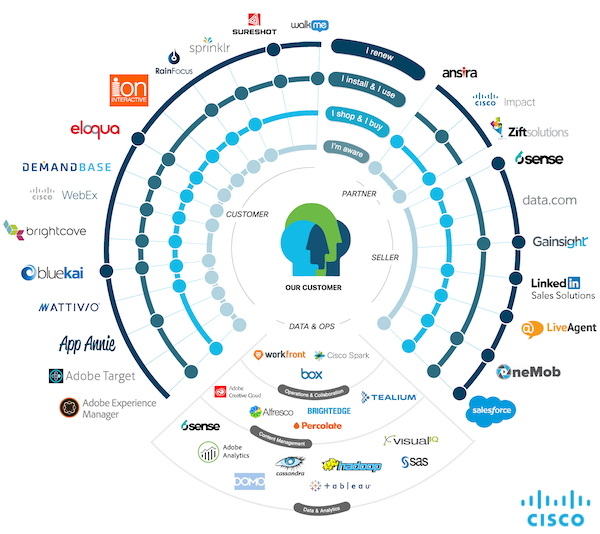The MarTech conference in San Francisco is less than two weeks away, and I’m really looking forward to kicking it off with the Stackies & Hackies awards reception on the evening of May 9. We received 57 marketing stack entries into the Stackies this year, plus 22 essays in the Hackies — so we’ll be making a donation of ((57+22)*$100) = $7,900 to Girls Who Code.
We’ll be releasing the full deck of all 57 marketing stacks after the awards ceremony, but I can’t resist sharing this stack from Cisco in advance. I’m immensely grateful for every company who contributes their stack diagram to the martech community, but I especially appreciate major brands like Cisco offering us a glimpse into their marketing technology operations.
This is a fantastic example of an elegantly organized, best-of-breed marketing stack — a master class in real-world marketing technology management condensed into a single slide:
- It features 39 different marketing technology solutions, including components from three of the major “marketing clouds” — Adobe, Oracle, and Salesforce — and dozens of leading specialist solutions for account-based marketing, social media marketing, content marketing, channel partner marketing, interactive content, mobile marketing, predictive analytics, and more. It also features, of course, Cisco’s own marketing technologies such as WebEx, Impact, and Spark.
- It’s fascinating to contrast a real-world heterogeneous stack diagram like this with the hypothetical homogeneous stack diagrams promoted by the major marketing clouds. Rather than trying to downplay this vibrant ecosystem, I really believe the major marketing clouds would be far better off leaning into the open platform opportunity that stacks like this represent. Seriously, if you examine all the technologies in Cisco’s stack, there’s not a single-vendor “marketing cloud” that comes close to offering all of these capabilities.
- It’s customer-centric with the customer literally at the center of their diagram. Four concentric circles emanating from that center define four stages of their buyer’s journey: (1) I’m aware, (2) I shop & buy, (3) I install & I use, and (4) I renew. Each martech solution is identified by the stages of that journey in which it operates — some focused on one specific stage, others providing continuity across all four as “systems of record.”
- The circles are divided into four segments, (1) customer, (2) partner, (3) seller, and (4) data & ops. The first three illuminate how different marketing technologies support direct and indirect engagements with customers. This is a great view of a stack for a company that employs both direct and channel-based sales. The last segment is focused on internal marketing operations, including collaboration services, content management, and data and analytics.
Although this stack diagram doesn’t explicitly show it, I’m going to infer that these different components are pretty well integrated. That inference is partly from the fact that each of these product vendors publicly promote their integrations with each other, and partly from the fact that from this diagram you can tell that Cisco has obviously thought through the operation of their stack very carefully. One can also infer from the inclusion of products like Cassandra, Hadoop, and Tableau — probably to enable a data science team in marketing — that they’re savvy about leveraging APIs to pass data between these systems on their own terms.
While such integration work was previously considered a downside to best-of-breed stacks, I think the fluency of orchestrating across marketing, sales, and custom internal systems has become a real organizational asset. And although Cisco is a large company, I’m seeing this capability develop at much smaller companies too — welcome to marketing in a digital world.
Want to learn how stacks like this are created and managed? Come join us at the MarTech conference in San Francisco, May 9-11. I guarantee: it will be the most real-world view of marketing technology management that you’ll find at any event this year.




